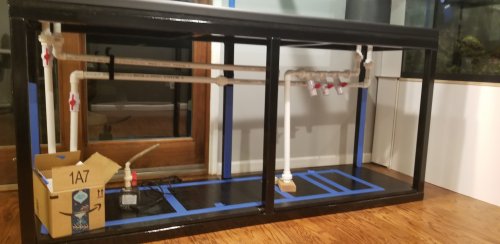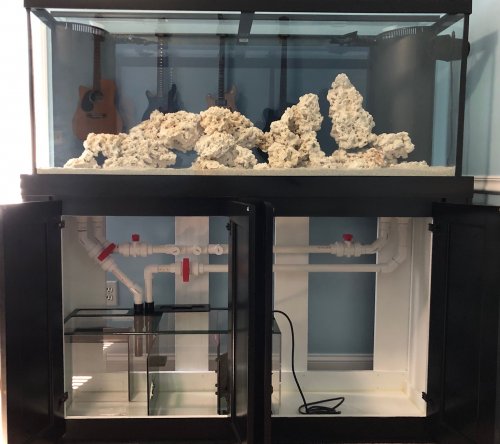-
Folks, if you've recently upgraded or renewed your annual club membership but it's still not active, please reach out to the BOD or a moderator. The PayPal system has a slight bug which it doesn't allow it to activate the account on it's own.
You are using an out of date browser. It may not display this or other websites correctly.
You should upgrade or use an alternative browser.
You should upgrade or use an alternative browser.
Plumbing question
- Thread starter Emmanuel
- Start date
Itll be ok. You may get a little less flow bc of the 90° turn but wont really be noticable.
I also noticed that you have valves on your drains, but I dont see a safety drain? You may want your returns to be safety's and return from the pump to come over the top of the tank..
Thanks I was thinking about thatI also noticed that you have valves on your drains, but I dont see a safety drain? You may want your returns to be safety's and return from the pump to come over the top of the tank..
Should I change it from a 90 to 2 45s?Itll be ok. You may get a little less flow bc of the 90° turn but wont really be noticable.
In a small.run like that I dont think your really seeing much of a difference. They also make a vent 90 which has more of a rounded edge instead of such a hard turn.Should I change it from a 90 to 2 45s?
They also have long turn 90s and street 90s. But not sure what you can find in 1in
ThanksYou will be fine. However. If your inclined to change it. Two 45s although better Does not hold a candle to a sweeping pre-bent 90. Not necessary but almost completely prevents any restrictions
Thanks this is my first time plumbing wanted to be sureBrs did a video a couple years ago about the difference between a 90 and two 45. If I remember right there was basically no difference in flow.
Times 10 100% agree. Same for me.I plumbed a 120 dial corner overflow nearly the same exact way. Spend the money on the brs gate valves. The back valves suck.
DangerDave
NJRC Member
The 90s will slow down the time to get to syphon. Should be fine. I'd be more worried about the valve your using. Get a gate valve, it will be much easier to fine tune it.
You can use one of the 3/4 returns as an emergency. And use the other as a return. Or use both as emergency drains and then return over the top
Not to hijack your thread, but what is everyone doing for an emergency overflow on the dual corner tanks? This setup is basically a snail or clump of algae getting stuck in one overflow away from spilling the tank all over the floor.
View attachment 26223
Couldn't one use a float switch for this purpose?
Couldn't one use a float switch for this purpose?
Meaning a float switch to control the return pump?
Yes you could use a float but it’s not as ideal It would protect from overflow but will turn off the return pump. That’s not good. If you were away you could go a long time without it. The previous suggestion is ideal. Over the top for return. Stand pipes become safety. By adding the over the top you have enough left to essentially have a bean animal. Which is super ideal. Safe and nearly silent.
A valve in a return line suggests that the line will or could be used as a syphon drain, or worse, accidentally closed. You cannot expect to run a tank with 2 syphon drains and no addition safety drains. This is especially true with ball valves.
First, you may overflow the tank before the syphons start. Note that most syphon drains start several inches below the overflow water level for this reason with a safety drain or sometime 2 located a half inch or so below the tank water level. It is impossible to exactly match 1 or 2 syphons with the return for any significant length of time! It is hard enough to balance a tank with one emergency drain and one syphon drain with a good gait valve for a short time.
Second, drains will clog over time. I usually have 10 small snails in my sock through the syphon drain each time I replace a sock. I often have to temporarily open the valve and reset it to clear the syphon line of debris. My gait valve is only open about 1/8 the area of my pipe ID, so it doesn't take a large snail to clog it.
Third, if you close the wrong valve by accident, you will quickly overflow the tank.
The best advice I can give you is: ALWAYS HAVE at least ONE OVERFLOW DRAIN LINE WITH NO VALVE, sized to drain water faster that the return can send it back up.(Note water drains slower without a syphon due to air.). If you only want two drains, only one can be a syphon. If you only want one drain, it can not be a syphon drain.
If you want a quiet drain system, you will want the bulk of the water to flow down through the syphon drain (s).
In your situation, you could have 2 syphon drains, one in each corner, with 2 emergency drains, one in each corner. One emergency drain would be set slightly higher to allow a slight amount or water to overflow, and the other slightly higher to act as a dry emergency drain, which only sees water if one or more of the drains become clogged. It is common practice to terminate the emergency drain slightly above the sump water level to signal a clogged drain issue. the other lines should terminate about an inch below. (or you get salt creep) The alternate is to have one syphon in one corner and an overflow drain in the other with little water draining, but that defeats the purpose of dual overflows. Usually one syphon drain will start before the other.
Most tanks are sold with the assumption that you will use a non-syphon durso drain in each overflow (and get salt creep due to bubbles). If you want a silent syphon overflow, you need to bring the returns over the back of the tank by changing the return lines into overflow or emergency drains.
First, you may overflow the tank before the syphons start. Note that most syphon drains start several inches below the overflow water level for this reason with a safety drain or sometime 2 located a half inch or so below the tank water level. It is impossible to exactly match 1 or 2 syphons with the return for any significant length of time! It is hard enough to balance a tank with one emergency drain and one syphon drain with a good gait valve for a short time.
Second, drains will clog over time. I usually have 10 small snails in my sock through the syphon drain each time I replace a sock. I often have to temporarily open the valve and reset it to clear the syphon line of debris. My gait valve is only open about 1/8 the area of my pipe ID, so it doesn't take a large snail to clog it.
Third, if you close the wrong valve by accident, you will quickly overflow the tank.
The best advice I can give you is: ALWAYS HAVE at least ONE OVERFLOW DRAIN LINE WITH NO VALVE, sized to drain water faster that the return can send it back up.(Note water drains slower without a syphon due to air.). If you only want two drains, only one can be a syphon. If you only want one drain, it can not be a syphon drain.
If you want a quiet drain system, you will want the bulk of the water to flow down through the syphon drain (s).
In your situation, you could have 2 syphon drains, one in each corner, with 2 emergency drains, one in each corner. One emergency drain would be set slightly higher to allow a slight amount or water to overflow, and the other slightly higher to act as a dry emergency drain, which only sees water if one or more of the drains become clogged. It is common practice to terminate the emergency drain slightly above the sump water level to signal a clogged drain issue. the other lines should terminate about an inch below. (or you get salt creep) The alternate is to have one syphon in one corner and an overflow drain in the other with little water draining, but that defeats the purpose of dual overflows. Usually one syphon drain will start before the other.
Most tanks are sold with the assumption that you will use a non-syphon durso drain in each overflow (and get salt creep due to bubbles). If you want a silent syphon overflow, you need to bring the returns over the back of the tank by changing the return lines into overflow or emergency drains.



